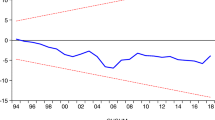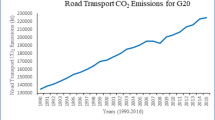Abstract
The study investigates the causal relationships between road energy consumption, economic growth, urbanization and population growth in Egypt over the period (1980–2011). I use Johansen cointegration approach, vector error correction model (VECM), generalized impulse response functions and variance decomposition technique. The results show the existence of long-run relationship between the variables. Moreover, the results indicate the existence of unidirectional long-run causality running from road energy consumption to urbanization and from road energy consumption to economic growth which implies the existence of growth hypothesis in the long run. Also, there is bidirectional short-run causality between road energy consumption and economic growth, which indicates the existence of feedback hypothesis in the short run. These results imply that road energy consumption determines economic growth in the both short run and long run and economic growth causes road energy consumption in the short run. And according to these results, several policy implications will be suggested for policymakers. They should take into consideration while implementing energy conservation policies, the possible negative effect on economic growth and have to concentrate on technological development policies and to make a shift towards using clean alternative fuel as natural gas and focus on investment in renewable energy resources.

Similar content being viewed by others
References
Acaravci, A., & Ozturk, I. (2010). On the relationship between energy consumption, CO2 emissions and economic growth in Europe. Energy, 35(12), 5412–5420. doi:10.1016/j.energy.2010.07.009.
Achour, H., & Belloumi, M. (2016). Investigating the causal relationship between transport infrastructure, transport energy consumption and economic growth in Tunisia. Renewable Sustainable Energy Reviews, 56, 988–998. doi:10.1016/j.rser.2015.12.023.
Ahmed, W., Zaman, K., Sadaf Taj, S., Rustam, R., Waseem, M., & Shabir, M. (2013). Economic growth and energy consumption nexus in Pakistan. South Asian Journal of Global Business Research, 2(2), 251–275. doi:10.1108/SAJGBR-05-2011-0010.
Alam, A. (2013). Electric power consumption, foreign direct investment and economic growth. World Journal of Science, Technology and Sustainable Development, 10(1), 55–65. doi:10.1108/20425941311313100.
Al-mulali, U., Fereidouni, H. G., Lee, J. Y. M., & Sab, C. N. B. (2013). Exploring the relationship between urbanization, energy consumption and CO2 emissions in MENA countries. Renewable and Sustainable Energy Reviews, 23, 107–112. doi:10.1016/j.rser.2013.02.041.
Ang, J. B. (2007). CO2 emissions, energy consumption and output in France. Energy Policy, 35(10), 4772–4778. doi:10.1016/j.enpol.2007.03.032.
Aslan, A., Apergis, N., & Yildirim, S. (2014). Causality between energy consumption and GDP in the US: Evidence from wavelet analysis. Front Energy, 8(1), 1–8. doi:10.1007/s11708-013-0290-6.
Azam, M., Khan, A. Q., Bakhtyar, B., & Emirullah, C. (2015). The causal relationship between energy-consumption and economic growth in the ASEAN-5 countries. Renewable and Sustainable Energy Reviews, 47, 732–745. doi:10.1016/j.rser.2015.03.023.
Banafea, W. A. (2014). Structural breaks and causality relationship between economic growth and energy consumption in Saudi Arabia. International Journal of Energy Economics and Policy, 4(4), 726–734.
Bekhet, H. A., & Othman, N. S. (2011). Causality analysis among electricity consumption, consumer expenditure, gross domestic product (GDP) and foreign direct investment (FDI): Case study of Malaysia. Journal of Economics and International Finance, 3(4), 228–235.http://www.academicjournals.org/journal/JEIF/article-abstract/5FE5F7B4786.
Belloumi, M. (2009). Energy consumption and GDP in Tunisia: Cointegration and causality analysis. Energy Policy, 37(7), 2745–2753. doi:10.1016/j.enpol.2009.03.027.
Ben Abdallah, K., Belloumi, M., & De Wolf, D. (2013). Indicators for sustainable energy development: A multivariate cointegration and causality analysis from Tunisian road transport sector. Renewable Sustainable Energy Reviews, 25, 34–43. doi:10.1016/j.rser.2013.03.066.
Central Agency for Public Mobilization & Statistics (CAPMAS). (2016). Egypt in figures, Arab Republic of Egypt.
Chandran, V. G. R., & Tang, C. F. (2013). The impacts of transport energy consumption foreign direct investment and income on CO2 emissions in ASEAN-5 economies. Renewable and Sustainable Energy Reviews, 24, 445–453. doi:10.1016/j.rser.2013.03.054.
Costantini, V., & Martini, C. (2010). The causality between energy consumption and economic growth: A multi-sectoral analysis using non-stationary cointegrated panel data. Energy Economics, 32(3), 591–603.
Economic and Social Commission for Western Asia (ESCWA). (2014). Policy reforms to promote energy efficiency in the transportation sector in Egypt.
EIA (US Energy Information Administration). (2015). International Energy Statistics. Available online at: https://www.eia.gov/beta/international/analysis.
El-Dorghamy, A., Allam, H., Al-Abyad, A., & Gasnier, M. (2015). Fuel economy and CO 2 emissions of light duty vehicles in Egypt. Al Matar: Centre for Environment and Development in the Arab Region and Europe.
Engle, R., & Granger, C. (1987). Cointegration and error correction: representation, estimation and testing. Econometrica, 55(2), 251–276.
Fedderke J. W., & Bogeti Z. (2006). Infrastructure and growth in South Africa: Direct and indirect productivity. Impacts of 19 infrastructure measures. World Bank Policy Research Working Paper 3989.
Halicioglu, F. (2007). Residential electricity demand dynamics in Turkey. Energy Economics, 29(2), 199–210. doi:10.1016/j.eneco.2006.11.007.
Halicioglu, F. (2009). An econometric study of CO2 emissions, energy consumption, income and foreign trade in Turkey. Energy Policy, 37(2), 1156–1164. doi:10.1016/j.enpol.2008.11.012.
Hossain, Md S. (2011). Panel estimation for CO2 emissions, energy consumption, economic growth, trade openness and urbanization of newly industrialized countries. Energy Policy, 39(11), 6991–6999. doi:10.1016/j.enpol.2011.07.042.
Howeidy, A. (2009). Cairo’s informal areas between urban challenge and hidden potentials, facts, voices, visions. Criterio Produca Grafica, Lda. Portugal.
Hwang, J. H., & Yoo, S. H. (2014). Energy consumption, CO2 emissions, and economic growth: Evidence from Indonesia. Quality & Quantity, 48(1), 63–73. doi:10.1007/s11135-012-9749-5.
Iwata, H., Okada, K., & Samreth, S. (2010). Empirical study on the environmental Kuznets curve for CO2 in France: The role of nuclear energy. Energy Policy, 38(8), 4057–4063. doi:10.1016/j.enpol.2010.03.031.
Johansen, S. (1988). Statistical analysis of cointegrating vectors. Journal of Economic Dynamics and Control, 12(2–3), 231–254.
Johansen, S., & Juselius, K. (1990). Maximum likelihood estimation and inference on cointegration with applications, the demand for money. Oxford Bulletin of Economics and Statistics, 52(2), 169–210.
Joyeux, R., & Ripple, R. D. (2011). Energy consumption and real income: A panel cointegration multi-country study. Energy Journal, 32(2), 107–141.
Kargi, B. (2014). Electicity consumption and Economic growth: A long-term co-integrated analysis for Turkey. International Journal of Economics and Finance, 6(4), 285–293. doi:10.5539/ijef.v6n4p285.
Kraft, J., & Kraft, A. (1978). On the relationship between energy and GNP. Journal of Energy and Development, 3(2), 401–403.
Kyophilavong, P., Shahbaz, M., Anwar, S., & Masood, S. (2015). The energy-growth nexus in Thailand: Does trade openness boost up energy consumption? Renewable and Sustainable Energy Reviews, 46, 265–274. doi:10.1016/j.rser.2015.02.004.
Liddle, B. (2009). Long-run relationship among transport demand, income, and gasoline price for the US. Transportation Research Part D, 14(2), 73–82. doi:10.1016/j.trd.2008.10.006.
Liddle, B. (2012). The systematic, long-run relation among gasoline demand, gasoline price income and vehicle ownership in OECD countries: Evidence from panel cointegration and causality modeling. Transportation Research Part D, 17(4), 327–331. doi:10.1016/j.trd.2012.01.007.
Liddle, B. (2014). Impact of population, age structure, and urbanization on carbon emissions/energy consumption: Evidence from macro-level, cross-country analyses. Population and Environment, 35(3), 286–304. doi:10.1007/s11111-013-0198-4.
Liddle, B., & Lung, S. (2013). The long-run causal relationship between transport energy consumption and GDP: Evidence from heterogeneous panel methods robust to cross-sectional dependence. Economics Letters, 121(3), 524–527. doi:10.1016/j.econlet.2013.10.011.
Liddle, B., & Lung, S. (2014). Might electricity consumption cause urbanization instead? Evidence from heterogeneous panel long-run causality tests. Global Environmental Change, 24, 42–51. doi:10.1016/j.gloenvcha.2013.11.013.
Liddle, B., & Lung, S. (2015). Revisiting energy consumption and GDP causality: Importance of a priori hypothesis testing, disaggregated data and heterogeneous panels. Applied Energy, 142, 44–55. doi:10.1016/j.apenergy.2014.12.036.
Lin, B., & Jr, P. K. (2014). Energy consumption and economic growth in South Africa reexamined: A non-parametric testing approach. Renewable and Sustainable Energy Reviews, 40, 840–850. doi:10.1016/j.rser.2014.08.005.
Liu, Y. (2009). Exploring the relationship between urbanization and energy consumption in China using ARDL(autoregressive distributed lag) and FDM (factor decomposition model). Energy, 34(11), 1846–1854. doi:10.1016/j.energy.2009.07.029.
Masih, A. M. M., & Masih, R. (1996). Energy consumption, real income and temporal causality: Results from a multi-country study based on cointegration and error correction modelling techniques. Energy Economics, 18(3), 165–183.
Narayan, P. K., & Popp, S. (2012). The energy consumption-real GDP nexus revisited: Empirical evidence from 93 countries. Economic Modelling, 29(2), 303–308. doi:10.1016/j.econmod.2011.10.016.
Narayan, P. K., & Smyth, R. (2008). Energy consumption and real GDP in G7 countries: New evidence from panel cointegration with structural breaks. Energy Economics, 30(5), 2331–2341. doi:10.1016/j.eneco.2007.10.006.
Pala, A. (2016). Which energy growth hypothesis is valid in OECD countries? Evidence from panel causality analysis. International Journal of Energy Economics and Policy, 6(1), 28–34.
Pradhan, R. P. (2010). Transport infrastructure, energy consumption and economic growth triangle in India: Cointegration and causality analysis. Journal of Sustainable Development, 3(2), 167–173.
Pradhan, R. P., & Tapan, P. B. (2013). Effect of transportation infrastructure on economic growth in India: The VECM approach. Research in Transportation Economics, 38(1), 139–148. doi:10.1016/j.retrec.2012.05.008.
Rafiq, S., & Salim, R. (2009). Temporal causality between energy consumption and income in six Asian emerging countries. Applied Economics Quarterly, 55(4), 1–16. doi:10.3790/aeq.55.4.335.
Ragab, A., & Fouad, H. (2009). Roads and highways in Egypt: Reform for enhancing efficiency. The Egyptian Center for Economic Studies, Working paper No. 152.
Ramanathan, R. (2001). The long-run behavior of transport performance in India: A cointegration approach. Transportation Research Part A, 35(4), 309–320.
Saboori, B., Sapri, M., & Baba, M. (2014). Economic growth, energy consumption and CO2 emissions in OECD (Organization for Economic Co-operation and Development)’s transport sector: A fully modified bi-directional relationship approach. Energy, 66, 140–161. doi:10.1016/j.energy.2013.12.048.
Salim, R., & Bloch, H. (2009). Expenditures on business R&D and trade performance in Australia: Is there a link? Applied Economics, 41, 351–361. doi:10.1080/00036840601007302.
Salim, R., Rafiq, S., & Hassan, A. F. M. K. (2008). Causality and dynamics of energy consumption and output: Evidence from non-OECD Asian countries. Journal of Economic Development, 33, 1–26.
Samimi, R. (1995). Road transport energy demand in Australia: A cointegration approach. Energy Economics, 17(4), 329–339.
Shahbaz, M., Loganathan, N., Muzaffar, A. T., Ahmed, K., & Jabran, M. A. (2016). How urbanization affects CO2 emissions in Malaysia? The application of STIRPAT model. Renewable and Sustainable Energy Reviews, 57, 83–93. doi:10.1016/j.rser.2015.12.096.
Solarin, S. A., & Shahbaz, M. (2013). Trivariate causality between economic growth, urbanization and electricity consumption in Angola: Cointegration and causality analysis. Energy Policy, 60, 876–884. doi:10.1016/j.enpol.2013.05.058.
Soytas, U., Sari, R., & Ozdemir, O. (2001). Energy consumption and GDP relations in Turkey: A cointegration and vector error correction analysis, economies and business in transition. In Facilitating competitiveness and change in the global environment proceedings (pp. 838–844). Global Business and Technology Association.
Tang, C. F. (2009). Electricity consumption, income, foreign direct investment, and population in Malaysia: New evidence from multivariate framework analysis. Journal of Economic Studies, 36(4), 371–382. doi:10.1108/01443580910973583.
The World Bank. (2015). World development indicators (WDI), Washington, DC [Online]. https://data.worldbank.org/data-catalog/world-development-indicators. Accessed June 26, 2015.
United Nations Statistics Division (unstats), 2014 Energy Balances. United Nations, New York, 2016. http://unstats.un.org/unsd/energy/balance/2014/bcf.pdf.
World Energy Council. (2011). Global transport scenarios 2050. https://www.worldenergy.org/wp-content/uploads/2012/09/wec_transport_scenarios_2050.pdf.
Yazdi, S. K., & Shakouri, B. (2014). The impact of energy consumption, income, trade, urbanization and financial development on carbon emissions in Iran. Advances in Environmental Biology., 8(5), 1293–1300.
Yu, E. S. H., & Choi, J. Y. (1985). The causal relationship between energy and GNP: An international comparison. Journal of Energy and Development, 10(2), 249–272.
Zhang, C., & Lin, Y. (2012). Panel estimation for urbanization, energy consumption and CO2 emissions: A regional analysis in China. Energy Policy, 49, 488–498. doi:10.1016/j.enpol.2012.06.048.
Author information
Authors and Affiliations
Corresponding author
Rights and permissions
About this article
Cite this article
Ibrahiem, D.M. Road energy consumption, economic growth, population and urbanization in Egypt: cointegration and causality analysis. Environ Dev Sustain 20, 1053–1066 (2018). https://doi.org/10.1007/s10668-017-9922-z
Received:
Accepted:
Published:
Issue Date:
DOI: https://doi.org/10.1007/s10668-017-9922-z




